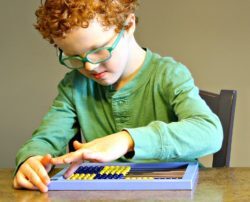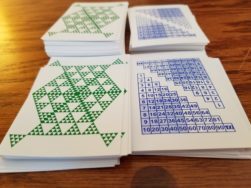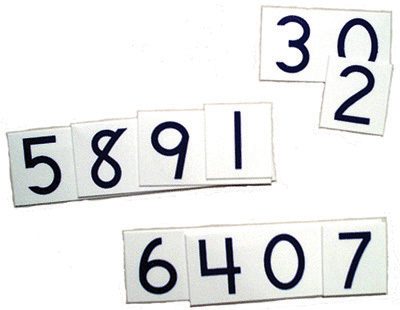Here are some evidence-based strategies that RightStart™ Math naturally incorporates in the lessons to support students with dyslexia:
1. Students with dyslexia learn best with multisensory input.

RightStart™ Math helps students with dyslexia learn and understand math by incorporating at least one manipulative in every lesson.
The manipulatives are visualizable and are used to help students see how math works.
Each activity using the manipulative includes discovery and explicit instruction to help students understand math facts and math processes.
2. Students with dyslexia struggle with writing and completing worksheets.
RightStart™ Math reduces the amount of written work by having students practice skills and demonstrate their understanding through math card games and verbal responses.
During the lesson, the teacher asks questions, and the student explores the manipulative and answers the question verbally.

To practice math facts and processes, students play math card games. The games will produce the same math facts as included on worksheets, but students do not need to write the answers.
I always recommend that the students say the math facts out loud as they play the games to develop greater fluency.
3. Students with dyslexia tend to have working memory deficits.
Games
Because students with dyslexia struggle to remember math facts, they need a significant amount of practice, specifically interesting practice.
As stated previously, RightStart™ Math incorporates games into the lessons to help students practice math facts and processes.
There are numerous games available to teach skills, keeping the practice interesting and engaging.
Strategies
The program develops math fact fluency through strategies to help the student learn the facts, reducing the need for rote memorization.
Jo Boaler, an author and math education professor at Stanford University, said this,
“I have never committed math facts to memory, although I can quickly produce any math fact, as I have number sense and I have learned good ways to think about number combinations.”
RightStart™ Math helps students learn number sense and strategies to help them solve math facts quicker, without draining their mental energy on memorization.
Review
To ensure students with dyslexia are learning and retaining what is being taught, RightStart™ Math also incorporates daily review through Warm-Up exercises and games.
In addition, there are frequent review lessons and assessments. That way, the teacher knows what the students are learning, what they are retaining, and what needs to be reviewed.
4. Students with dyslexia learn better when lessons are taught in smaller chunks.
RightStart™ Math lessons are two pages in length, and that includes pictures of the manipulatives being used.
Dr. Cotter, the author of RightStart™ Math, has students with dyslexia learn processes in steps. One lesson will build on another lesson until the student has a solid grasp of the full process.
5. Students with dyslexia need comprehension support.
Children with dyslexia cannot retain information through rote memorization. They need to understand how things work.
RightStart™ Math is all about helping students understand math concepts, not just memorize processes. When students understand how something works and why, they are more likely to remember the process for it. The company believes in this so strongly that it is included in its mission statement:
RightStart™ Math: helping everyone understand, apply, and enjoy mathematics.
6. Students with dyslexia tend to have auditory processing disorders.
This tends to show itself most notably in spelling when students cannot differentiate between the short vowel sound ‘i’ and the short vowel sound ‘e.’
However, this disorder can also cause difficulties in math, specifically when the student with dyslexia cannot hear the difference between ‘forty’ and ‘fourteen.’
Math way of saying numbers
RightStart™ Math presents quantities in various ways to help students with auditory processing disorder ‘hear’ the difference between these two quantities. One strategy used in the curriculum is to temporarily use the math way of saying numbers.
For example, students will hear and say the place value, such as ten four (for fourteen) and four ten (for forty). Not only can the students hear the difference between the two words, but they also are developing place value sense.
Place value cards

Students will also use place value cards and the Cotter Abacus to visualize and demonstrate an understanding of place value through manipulatives. The teacher can see if the student is misunderstanding the word by looking at what they are building.
For example, if the teacher asks the student to enter 14 on the abacus or build 14 using place value cards and the student builds 40, then the teacher can quickly see that the student is misunderstanding what is being said.
Quick student feedback
I have found when students learn both the traditional names and the math way of saying a number, they develop a better grasp of place value.
For students with an auditory processing disorder, the teacher can check for understanding of a quantity by having them do the following:
- Say the number the math way
- Show the quantity using the abacus and/or place value cards.
By using this process, the teacher can quickly determine if the student is hearing the number correctly.
Summary
Children with dyslexia need to have math presented to them in a way they can understand. The RightStart™ approach to teaching math not only helps these students learn, but they can understand and enjoy it.
For more information about how RightStart™ Math can help your students learn, contact us!
